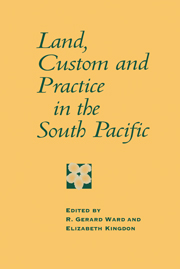Book contents
- Frontmatter
- Contents
- List of Figures
- List of Tables
- Contributors
- Acknowledgements
- Introduction
- 1 Land Use and Tenure: Some Comparisons
- 2 Land Tenure in the Pacific Islands
- 3 Breathing Spaces: Customary Land Tenure in Vanuatu
- 4 From Corporate to Individual Land Tenure in Western Samoa
- 5 Right and Privilege in Tongan Land Tenure
- 6 Land, Law and Custom: Diverging Realities in Fiji
- 7 Beyond the Breathing Space
- Bibliography
- Index
Introduction
Published online by Cambridge University Press: 10 November 2009
- Frontmatter
- Contents
- List of Figures
- List of Tables
- Contributors
- Acknowledgements
- Introduction
- 1 Land Use and Tenure: Some Comparisons
- 2 Land Tenure in the Pacific Islands
- 3 Breathing Spaces: Customary Land Tenure in Vanuatu
- 4 From Corporate to Individual Land Tenure in Western Samoa
- 5 Right and Privilege in Tongan Land Tenure
- 6 Land, Law and Custom: Diverging Realities in Fiji
- 7 Beyond the Breathing Space
- Bibliography
- Index
Summary
Life in the Pacific Islands has been transformed over the last century and a half, economically, geographically, politically and socially. Nevertheless, for the majority of islanders land is still central to their life and the land tenure arrangements which people use help shape their settlement patterns and agricultural systems, and are important components of socio-economic and political structures. The majority of land in all South Pacific Island countries remains under what are commonly described as ‘traditional’, ‘customary’ or ‘native’ land tenure systems. This book argues that in many parts of the region the ways in which the ‘customary’ land is now held by owners or users have changed to a much greater degree than is commonly acknowledged. The changes are intimately linked to concurrent changes in the socio-economic and political organisation of Pacific Island communities, but they are not unique to the region. They are specific cases which have, or have had, parallels in other parts of the world. The details are not identical, but the general processes of transformation have led to a widening range of situations in which land formerly held in common, or used through various communal arrangements, is now controlled and used exclusively by individuals or small family groups. In a broad sense much customary land is being privatised. Historical parallels can be found in Japan and China over the last millennium or more, in the mediaeval and later enclosure movements in Europe, and in Africa and insular Southeast Asia in the present century.
A central component of the socio-economic transformations, of which the tenure changes are part, is the change from subsistence to market economies.
- Type
- Chapter
- Information
- Land, Custom and Practice in the South Pacific , pp. 1 - 5Publisher: Cambridge University PressPrint publication year: 1995
- 1
- Cited by

